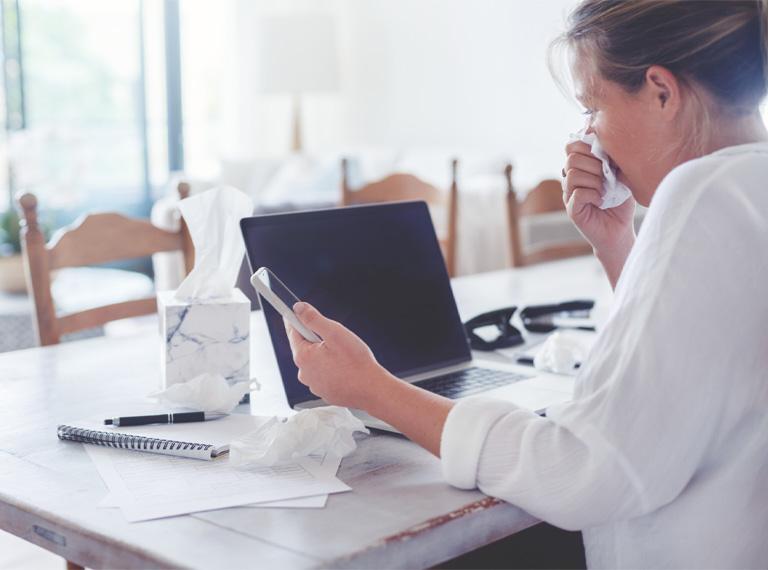What are the sick leave levels like in your organisation? According to new research by the Chartered Institute of Personnel and Development (CIPD) and insurance firm Simplyhealth, UK workers are taking two days more than pre-pandemic – that’s 7.8 days in the past year.
The research in CIPD’s ‘Health and Wellbeing at Work’ report shows coughs, colds, flu, and Covid are to blame for 94% of short-term, so-called ‘minor illness’, while mental ill health accounts for 63% of long-term absences. Statistics also indicate marked discontent between sectors, with public sector workers ‘more likely to feel exhausted and under excessive pressure’ than those in the private sector.
Leanne Spencer, award-winning keynote speaker, author, and founder of wellbeing consultancy Bodyshot Performance, regularly works with organisations to help embed wellbeing strategies, resulting in a stronger, more resilient and engaged workforce. In our interview, Leanne discusses how employers might achieve just this.
Watch the video or read the full interview below:

Q: Why do you think sick leave days are on the rise, as found in the CIPD study?
A: I think there’s a couple of things going on. Big picture: I think we’re in an interesting position because, if you go on LinkedIn and look at some of the posts people are putting up, we’re being told that it’s okay not to be okay. And by the way, all of this I’m completely behind. There’s no sense of disdain in what I'm saying. We’re being told, if you need to take time, take the time. Your health is the most important thing. And in all these good statements, some will be lip service from some companies and others will be heartily meant.
Also, you’re seeing posts on LinkedIn from people saying, ‘You know, I didn’t feel too great this morning, and I wrote to my boss and said, can I come in an hour later, and they said, “Hey, we’ve got you. You stay home and we will take on all your work for the day”.’ And then a celebratory post all about how fantastic their company is. And that is great. I think what we’re seeing is everyone’s looking at this and thinking, ‘Well, okay, if I’m a bit ill, it’s okay to ring in sick’. The culture has changed but the reality is that the work still needs to get done. And yes, certain employers may be more or less willing to make allowances like that.
So, I think we’re in a difficult position culturally with this big movement towards: ‘It’s okay not to be okay and if you’re unwell, stay off’.
We’re catching up from Covid and the general pace of business life, fuelled in part by comms perhaps, has just increased hugely. And I think that’s why we might be seeing a bit more sick leave.
So, in summary, we’re seeing a movement that’s encouraging people to prioritise themselves and their health and wellbeing, but I’m not sure that company culture has caught up with that. And I think the pace of business life has just increased and there are fewer moments to take a breath.
Q: The study found minor illnesses, musculoskeletal injuries and mental ill health were the main reasons for short-term absences. What could employers do to reduce these factors?
A: What employers are very good at is responding once there’s a problem that has been surfaced – what I mean by that is we’ve got employee assistance programmes. There is occupational health. There are resources that people can go to ranging from physical to mental health, if problems are identified. And when I say identified, it might be that person’s now on long-term sick leave or there’s a pattern of short term and frequent sick leave.
That’s a very reactive way of looking at things. I think what we need – and some forward- thinking companies are doing it – is to be very proactive in talking about preventative health – and I’ve got a bit of content that I'll share with you, which is around the four factors that make a happy, healthy and resilient human: [light, movement, social connections, and cadence].
Companies that put a focus on these four elements I think will do really well because it’s much more efficient in terms of human capital and cost to have preventative health in place, rather than reactive health.
Those factors include light: in terms of how much physical or how much natural light people are exposed to, and that will be harder in some industries goals than it will be in others. But it’s a really important factor to think about, whether someone’s working at home or in an office environment – and you can give some guidance on natural light and how to get little slivers of natural light.
Movement covers the musculoskeletal factor. It’s not natural for us to sit in a semi-hunched or hunched position over a desk for a desk-based worker. Get up every hour to do what we call little movement snacks: that could very simply be getting up, walking over to where the dog lies. He’s over there, give him a bit of a cuddle and come back. It’s a little pocket of movement. Or I could stand at the window and do a few air squats, or just sort of stretch out to a power pose and get some natural light, so you can do those two things at once. Also encourage people, if they’re able, to use standing desks, take walking meetings, standing huddles, and all those kinds of things to bring in a little bit more movement.
Looking at social connections, I think the new frontier of wellbeing will be social relationships and human connection, particularly for people working remotely. So, this plays to mental health piece, but also physical health. Physical health is profoundly affected by the quality and the quantity of good social relationships that we have. And for some people that might be one, for others it could be many. I think that’s a really important part of happy, healthy, resilient human.
And then introducing this idea of cadence, and that’s basically that we don’t expect people to perform at a high level all year round. Ultimately, that can lead to chronic stress and burnout. So, the idea of cadence is that we get ready for the big repeatable busy periods that we may have in our roles and then get little bits of recovery before we go again.
It’s just introducing a cadence to the way we approach our work and that’s a really big idea. I think companies are starting to recognise that we can’t drive people at a fast, furious pace all the time.
Q: In your work with employers, what staff health concerns do they raise most often?
A: Predominantly, it’s what would be considered to sit under the banner of mental health, but also physical health, which would be chronic stress and burnout – that’s what I'm seeing a lot of. I think the chronic stress comes back to the pace at which we do business now. The pace at which we live arguably goes against the grain of what we were designed to do.
You can literally shake off stress and anxiety. There are some techniques for that, but what we tend to do is go from one stressful event to another: getting up in the morning, kids don’t want to go to school, getting onto a packed train, getting into an office where we’re already 10 minutes late for a meeting and then you’re on catch-up for the rest of the day. There isn’t really any opportunity to get that little bit of relief, and that’s generally what I think working life has become: one thing after another. I’m amazed how often people tell me they haven't got time to take two minutes to look out of the window and just daydream.
So, I think the big idea of cadence is helping organisations understand that rather than expect that constant [pressure], they allow people to anticipate when they’re going to need their energies, get it done and after a little bit of recovery, go again.
But it isn’t just the pace of life, pace and rigours of business life that drive chronic stress and burnout. It could be an accumulation of everything you’ve got going on at home and in other areas of life. But they’re the main things that I’m seeing, and mental health conditions as well, which seem to be on the rise: anxiety, depression – maybe it’s just that we’ve got a little bit more of a culture that allows us to talk about this now.
Q: Should employees be more proactive in telling their employer about their health concerns, such as stress-related issues?
A: Yes, I think that’s a tricky one because of the relationship you have with your manager. I think to solve anything, it depends on the culture of the organisation. One thing I was really impressed with was a story I heard quite recently about the head of a government agency. He was relatively new into the organisation and was launching a new mental health app to about 900 staff at an all-hands meeting.
He got up on stage and everyone was expecting a five-minute chat about the app [along the lines of] ‘we hope you engage with it; this is the investment we’ve made – go out and use it’. And he did that. But then he spent 15 minutes talking about his own mental health, how he overcame challenges, and what he does from a preventative health standpoint.
You could have heard a pin drop in the room, apparently. All 900 people just couldn’t believe he’d spoken openly about this. I think that’s a really good way of setting that ‘it’s okay to talk about things’ culture. It’s not going to suit every leader, but I think if we want people to talk about how they’re feeling, we have to make sure [work] is considered a safe space and know that willingness to be open is role-modelled by managers and leaders.
What I think would be great and in a utopian world is having lots of preventative health strategies in place that not only enable people to take pre-emptive action against poor mental health or physical health and keep those things at bay, but make it easier for people to talk about things when they’re not going well for them.
It’s a complicated big issue, I think. But ultimately, yes, it’s a two-way communication, to prevent things from getting any worse.
Q: Do you recommend use of technology to help employees improve their wellbeing?
A: There are a couple of bits of technology I’m really keen on. One is something I wear (and I’ve no affiliation with this product at all) which is called an oura ring which is worn on any finger of either hand. It is a little bit spendy, but it’s a bit of tech that I’ve been wearing for years that tracks my sleep data to a very high degree, and also nervous system recovery data.
It looks at resting heart rate, HRV, which is a good indicator of how recovered your nervous system is. It looks at respiratory rate and body temperature. It’s a really good way of determining whether you’ve got over the stress, whether it’s physical, mental, emotional, spiritual, and whether you’re ready to go or whether your nervous system is still recovering.
Another bit of tech I really like is Firstbeat Bodyguard. It has two nodes – you wear one under the left breast, one on the right collarbone. There’s a little cable that links the two, and you wear these for three days. In that time, it tracks all the stress responses that person undergoes, so you’re able to tell whether somebody has had deep, restorative sleep, whether they’re getting little slivers of recovery during the day: so that two minutes’ daydreaming out the window, or the half-hour walk at lunchtime that is relaxing the nervous system, or in other words, providing some recovery.
There are some really great apps, and Headspace is commonly provided to companies. So yeah, I am in support of that. I think giving people the tools and then allowing them to pick and choose whether they utilise them or not is a really strong suggestion.
Searching for talented professionals to join your organisation, or looking to join a business that invests in its people? Contact one of our specialist consultants today.





